NO. 101 - THE ADMIRALTY TELEGRAPH SYSTEM IN THE ALRESFORD AREA
PART II - THE SEMAPHOHES.
by John Adams.
With the banishment of Napoleon to Elba on the 18th May 1814 it was natural to assume that the long war was over so on the 6th July the Admiralty directed that all the Shutter Telegraph lines were to be ''discontinued'' and sold off. The telescopes in use at the stations were to be returned to the Navy Office.
To confound everyone who thought that a permanent peace was in prospect, Napoleon escaped from Elba and landed in France on 1st May, 1815 and was soon in charge again. The Admiralty gave some thought to re-establishing the Shutter lines (in fact this was actually done with the Portsmouth line being used for a while until the victory at Waterloo on the 18th June, 1815 enabled the Board to consider their future plans without undue haste. The Shutters to Portsmouth were closed for a second time : but only ten days later a system of communication to the naval ports using movable arms instead of shutters would be established.
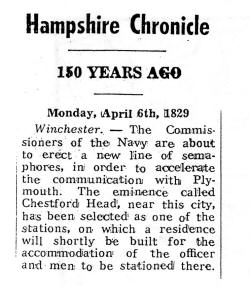
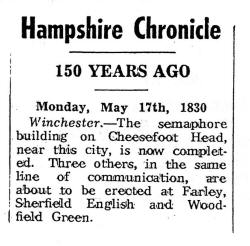
On 29th June an Act of Parliament authorised the Government to purchase the necessary sites (each one acre in extent) : this enabled the surveyor Thomas Goddard (who called each acre a "scite") to start planning the first Semaphore line to be started, that to Chatham and Sheerness.
The routes of the Semaphore lines often varied widely from those of the Shutters; for instance, the former passed right across the Alresford area whereas the latter had curved around the southern edge.
The Portsmouth line was authorised in 1820 and completed in 1822. Graham's design was chosen for the land lines in preference to Pasley's : but Popham who died in 1820, did not live to see his semaphore in operation. He had also produced a sea version for use between ships and ships and shore. This was superseded by Pasley's two arms from one pivot" design (illustrations page 14 ). The Plymouth branch was authorised in 1825 and left the Portsmouth line at Chatley Heath, passing over the Alresford district but coming to a full stop at Woodfield Green near where Hampshire, Wiltshire and Dorset meet. Many reasons, including economic ones were given in 1831 for the
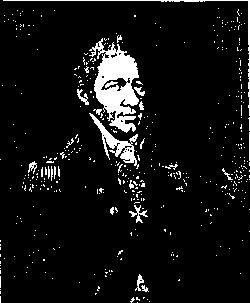
Rear Admiral Sir Home Riggs Popham
K.C.B. inventor of the Semaphore.
National Maritime Museum, Greenwich.
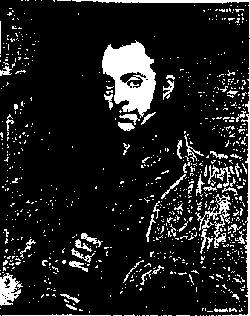
Lt. Gen. Sir Charles William
Pasley R.E. inventor or
modern Semaphore. Institution
of Royal Engineers Chatham.
decision to halt any more of the extension to Plymouth, but undoubtedly the success of the emerging railway network had some influence. The railway was developing an electric telegraph system, using its own code of bells and it seems that someone at Navy
Office could see the advantages of a scheme although awaiting further development which could be used irrespective of day or night or the weather. In 1839 the Navy Office was unable to use the electric telegraph to communicate with Portsmouth Dockyard, because the railway was forbidden to penetrate the Portsea Island fortifications. When the London and Southampton Railway obtained permission to build a branch from Eastleigh to Gosport and it opened in 1842 the Admiralty used the railway telegraph between Nine Elms and Gosport (Waterloo was not yet built) and by laying a cable on the bottom of Portsmouth harbour to the Semaphore Tower in the Dockyard it was able to communicate with naval authorities there. The semaphore line to Portsmouth closed in 1847.
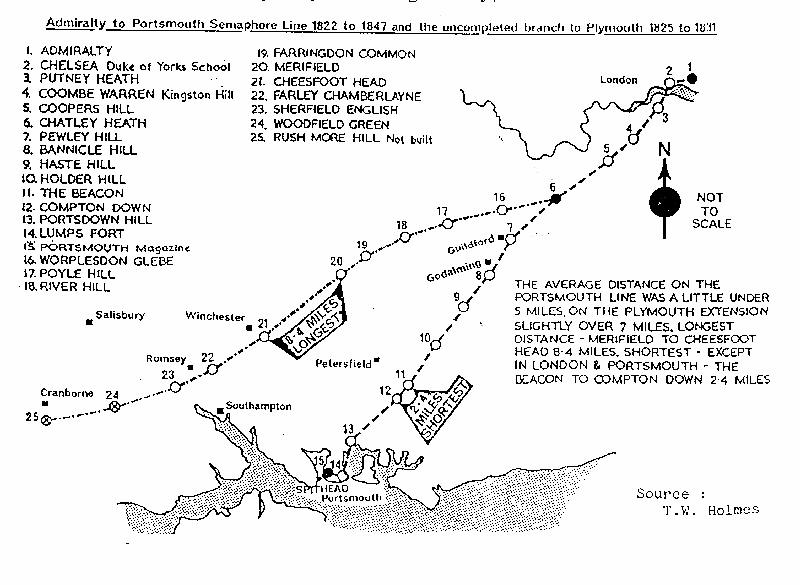
Admiral Popham had a long and distinguished naval career - he had served under our own Admiral Rodney of Old Alresford in action off Cape St. Vincent in 1780. He was an occasional visitor to Alresford house during the periods when Rodney was unemployed and on half-pay, and must have known the town quite well. It is clear from the Rodney papers that he used to discuss signals and communications frequently with George Rodney, who himself had used novel signals to the horror of the traditionalists to secure his "famous victory'' at the Battle or the Saintes in 1782 (see A.D.l7, Paper No. 90).
The three local semaphore stations on the Plymouth Branch have been accurately recorded by the Ordnance Survey (see plans 19,20,21) but little visible evidence remains with the exception of Farringdon Common which is now a private residence in Telegraph Road, Four Marks. All traces of Merifield have vanished but the careful searcher can find evidence of the remains of the cellar at Cheesefoot Head reference point.
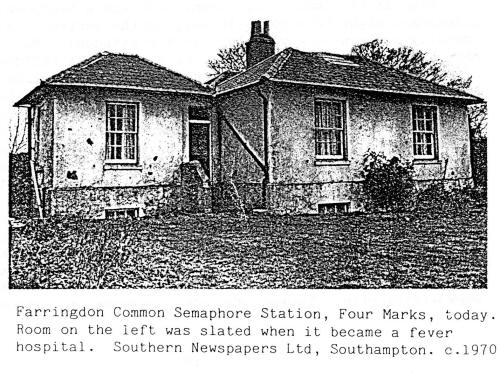
T. W. Holmes, from his deep research of the Telegraph lines, has classified the Semaphore buildings themselves into four types, and these are worth quoting:
Type A
A three storey building with wing rooms one on either side at ground floor level. It had a flat roof covered with lead. The Semaphore mast was stepped on a heavy beam in the floor of an upper room selected for this purpose. Each station had a cellar.
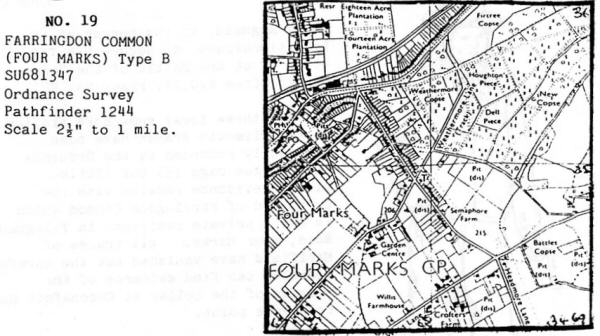
Type B
An ordinary looking country bungalow of four rooms with a washhouse and slate roof. The semaphore room was an attached but separate room with a flat lead roof on which the mast was stepped. These also had cellars. Farringdon Common and Cheesefoot Head were of this type.
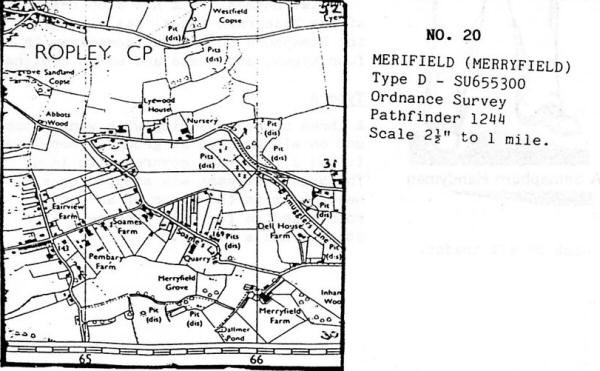
Type C
An octagonal tower of five storeys. The roof was reached by staircase then a ship's ladder through a heavy hatch-lid where the mast was stepped on a lead surface. A low parapet around the roofs about two feet high was quite alarming when a high wind was blowing. The mast and controls went down through the building to the Semaphore room on the first floor.
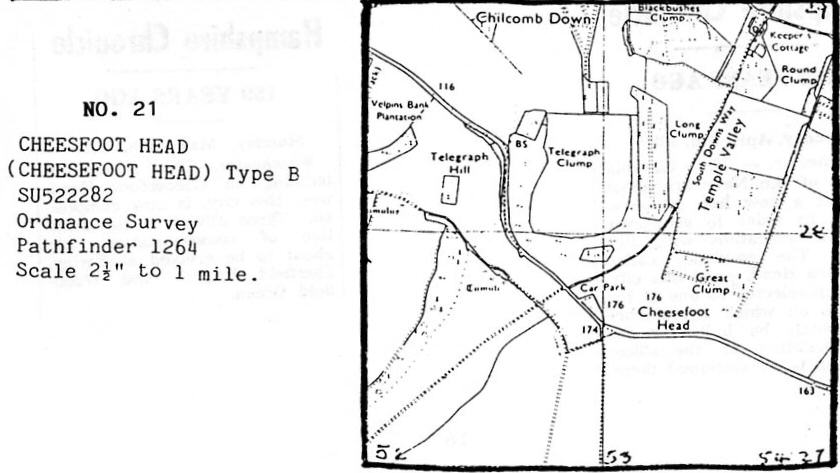
Type D
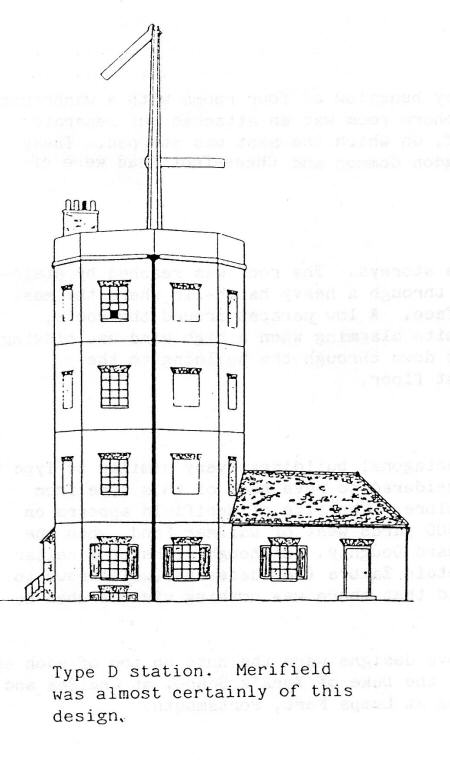 These were four storeyed octagonal buildings, very similar to Type C.
Merifield is generally considered to have been of this type from
the evidence of local folklore. The site of Merifield appears on
the tithe map of 1844 as 400 yards west of Dallmer Pond, when the
estate belonged to Sir Edward Doughty. Although signs of a cellar
were reported in 1972, Captain Zambra (now deceased) (well known to
many Ropley residents) said that there was nothing visible when he
farmed there in the l920s.
These were four storeyed octagonal buildings, very similar to Type C.
Merifield is generally considered to have been of this type from
the evidence of local folklore. The site of Merifield appears on
the tithe map of 1844 as 400 yards west of Dallmer Pond, when the
estate belonged to Sir Edward Doughty. Although signs of a cellar
were reported in 1972, Captain Zambra (now deceased) (well known to
many Ropley residents) said that there was nothing visible when he
farmed there in the l920s.
Exceptions to the above designs were the huts on top of each of the Admiralty Building and the Duke of York's School at Chelsea and a small two storey building at Lumps Fort, Portsmouth.
Station
Facilities
Manning
Each station had a Lieutenant R.N. and a Handyman. The Lieutenant might have domestic help in the person of a 'servant' (usually a woman cook who slept in the kitchen). Records show that many Lieutenants had large families 9, 10 or 11 children) so that although Their Lordships expected the Handyman to live in, the Lieutenant could pay him to live out in order to provide more space. If the Handyman had a family he had to live out, otherwise he was expected to 'sling a cot' in the Semaphore room. At the terminals there might be extra staff. The Handyman could be expected to use his abilities to solve any problem, as well as operating the Semaphore as his normal routine. For the actual reception or transmission of a message the Lieutenant took over the "glass" whilst the Handyman worked the "handles". Within the confines of this short paper it is impossible to go into the intricate details of the meaning or the different positions of the Semaphore arms, the use or otherwise of coded groups to abbreviate messages, as well as the actual mechanical arrangements which made the Semaphore work efficiently. Readers who are interested are strongly recommended to consult the listed sources, most of which are available through the Hampshire County Library Service, even if out of print.
Heating
"As much as sixpence per day will purchaser" was allowed for coals. This could be supplemented by wood picked up on the "common" land". Each station had a copper and bread-baking oven and each room had a fireplace. A lot of the coal allowance for remote stations was spent on the transport in getting it there.
Water
The supply of water was very much a hit and miss affair. Some stations had wells or rain-water tanks. Farringdon Common was supplied by water-cart, Meriield apparently had a well whilst Cheesefoot Head relied on rainwater.
Stores and supplies
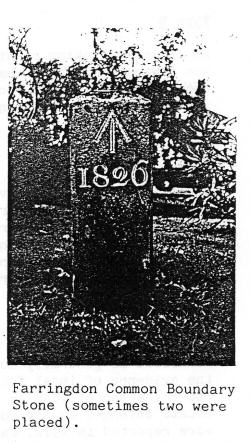 The three local stations were well supplied directly from
Portsmouth Dockyard.
The three local stations were well supplied directly from
Portsmouth Dockyard.
Pay and Allowances
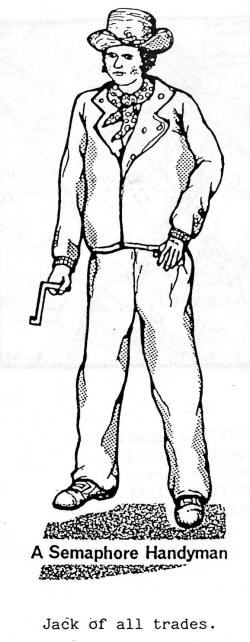 The job of Signal
Lieutenant, with the
coal money, would be
as remunerative as
that of a lieutenant
in a first-rate ship-of-the
line flagship (the
latter was paid 6d.
more than others).
For a veteran, usually
suffering from old
wounds, it was as attractive
as living an unemployed
sedentary life on half-pay.
No watches to keep,
no sea battles, and
at home all the time!
The job of Signal
Lieutenant, with the
coal money, would be
as remunerative as
that of a lieutenant
in a first-rate ship-of-the
line flagship (the
latter was paid 6d.
more than others).
For a veteran, usually
suffering from old
wounds, it was as attractive
as living an unemployed
sedentary life on half-pay.
No watches to keep,
no sea battles, and
at home all the time!
The Handyman, who was a Royal Navy seaman, had almost certainly worked previously on the Shutter system, and could regard this job as a sinecure. He had to be good with a telescope, to be able to manipulate the Semaphore and able to read and write. He would have no attention from the press gang or be subject to flogging and yet the usual causes of dismissal - if and when they-occurred - were insubordination or drunkenness. He would have learnt to write up the daily Journal at the Shutter station. Not all Handymen were pensioners, as many believe; their pay was slightly better than their colleagues serving at sea, and more if they were receiving payments for wounds. By the middle of the Semaphore era, the Handyman could have been receiving 85/- per month : thus he would have been financially better off than the average working man of the time, or a Petty Officer at sea.
Costs
The costs of construction of the Semaphore network greatly exceeded those of the Shutters, even allowing for the latter's cut price planning and construction in any form of comparison. Farringdon Common, built by Mr. Dyer of Alton, cost £987 Merifield was £1,394, while Cheesefoot Head was built for £850. Mention should be made that the station at Farrlngdon Common was used as an Isolation Hospital from 1896 to 1912 when the Alton Rural District Council rented the property for £25 per annum. Thereafter the station reverted to residential use.
John Adams November 1996.
SOURCES AND FURTHER READING
The Semaphore. T.W.
Holmes. A.H. Stockwell
Ltd. 1983
Signal. Captain Barrie Kent, R.N., Hyden House. 1993
The Old Telegraphs. Geoffrey Wilson. W & J Mackay. 1976
The Naval and Military Record. Various issues of the 1860s.
Hampshire Chronicle files.
The Ordnance Survey.
A few final words by T.W. Holmes:
"The amount of thought and work which went into these signalling systems was prodigious and although history gives the credit to the Reverend Lord George Murray and Rear-Admiral Sir Home Hoggs Pophaa as the inventors, the actual donkey work of establishing the lines was carried out by two very ordinary men. Extra-ordinary men would be a better description of them; they were dedicated to the work and did thoroughly efficient jobs.
For the Shutter system Mr. George Roebuck a civilian surveyor, was contracted to do the work while the Semaphore which came after wards was set up by Thomas Goddard who was Purser of the Royal Yacht, and who, in his own words was "working at times which most people dedicate to sleep or relaxation." Between the two of them, the systems covered a period of almost half a century, during which time the Admiralty could be in touch with ships at Spithead almost immediately, provided or course that the weather was right - and this at a time when the roads around Haslemere were quagmires in winter, and coaches crawled between Guildford and Godalming or were waylaid over Hindhead.
The second system, the Semaphore, ceased after the railways Were well under way, and which in their wake brought the electric telegraph. Naturally, this caused the demise of a signalling system which depended on clear day weather conditions in which to work. The fact remains that while these two signalling systems were in operation they were fast and efficient, and except in thick weather, reliable."